Understanding Sleep and Lighting
Sleep is crucial for overall health, influencing mood, cognitive function, and physical well-being. The role of bedroom lighting is often overlooked, yet it significantly impacts sleep quality. Light affects melatonin production, the hormone responsible for sleep regulation. Utilizing the right lighting can contribute to a serene sleep environment, fostering better sleep hygiene.
Types of Bedroom Lighting
1. Ambient Lighting
Ambient lighting serves as the primary light source in a room, illuminating the space evenly. For a bedroom, soft and warm ambient lighting is ideal. Consider using:
- Recessed Lighting: Installed in ceilings, recessed lights provide subtle illumination, maintaining a calm atmosphere.
- Table Lamps: Adjustable table lamps with dimmable options create an inviting space. Look for warm white LED bulbs to reduce harshness.
- Overhead Fixtures: Chandelier or pendant lights with a dimming feature can enhance aesthetics while providing ambient lighting.
2. Task Lighting
Task lighting is essential for activities like reading or working in bed. Utilizing the right fixtures prevents straining the eyes.
- Bedside Lamp: A low-wattage bedside lamp can offer enough light for reading without over-stimulating the eyes.
- Wall-mounted Sconces: These lights provide direct illumination without taking up bedside space and can often be adjusted to direct light where needed.
3. Accent Lighting
Accent lighting can add depth to your bedroom while enhancing the decor.
- LED Strip Lights: These can be placed along the edges of shelves or behind furniture to create a subtle glow.
- Mood Lighting: Fiber optic or color-changing bulbs can shift the light’s hue according to your mood, promoting relaxation.
Color Temperature and Light Management
The color temperature of the bulbs you choose is critical. Measured in Kelvin (K), this indicates how “warm” or “cool” the light appears.
- Warm Light (2200K – 3000K): Emulates sunrise and is conducive to relaxation. It promotes melatonin production, which aids sleep.
- Cool Light (4000K and above): Mimics daylight and can hinder the sleep-wake cycle, making it less suitable for the bedroom.
Considering this, opt for LED bulbs with a warm color temperature, as they are energy-efficient and have a longer lifespan.
Smart Lighting Solutions
Smart lighting solutions offer versatility and convenience in controlling bedroom lighting:
- Smart Bulbs: These allow for color changes and dimming through apps or voice commands. A gradual dimming feature can mimic natural sunset, easing the transition to sleep.
- Timers and Schedules: Set timers to prepare the room for sleep by dimming lights gradually. Simultaneously, you can program them to brighten in the morning, simulating a natural wake-up process.
- Motion Sensors: Automatic night lights with motion sensors can be beneficial. They offer safety during nighttime trips without being overly bright.
Light Blocking Techniques
For many, light pollution can be a significant disruptor of sleep. Here are ways to mitigate that:
- Blackout Curtains: These curtains block external light, creating a dark environment that promotes deep sleep. Ensure they fit snugly to eliminate gaps.
- Eye Masks: Using soft eye masks can also help block unwanted light, especially for those who are sensitive to light or travel frequently.
Natural Light Considerations
Natural light exposure during the day is crucial for a balanced sleep-wake cycle.
- Maximize Daylight: Use sheer drapes during the day to allow natural sunlight in, aiding mood and energy levels.
- Limit Blue Light Exposure: In the evening, reduce exposure to screens and blue light sources. Opt for warm-toned evening lighting to prepare your body for sleep.
Lighting Arrangement Tips
How you arrange lighting in your bedroom matters. Certain placements can create a serene atmosphere conducive to sleep.
- Layered Lighting: Include a combination of ambient, task, and accent lighting to create a warm and inviting environment.
- Dimming Options: Incorporate dimmers to control light levels quickly, enhancing the quality of your nighttime routine.
- Avoid Direct Eye Contact: Place lights so they are not directly shining into your eyes when in bed. This can help maintain a calm atmosphere.
The Role of Personal Preference
Ultimately, the best bedroom lighting for sleep will depend on individual preferences. Experiment with various fixtures and light intensity to find what works best for you.
- Personalization: Consider decorative elements that resonate with you, such as fairy lights, salt lamps, or unique lampshades.
- Textures and Materials: Soft materials can diffuse light beautifully. For example, fabric lampshades can create a warm glow, while mirrored surfaces can enhance light distribution.
Conclusion
Integrating quality lighting in your bedroom can enhance sleep health significantly. Pay attention to color temperatures, light arrangement, and personal comfort to create your sanctuary for restful nights. Balancing brightness levels and using guiding principles of design will assist in forming a conducive atmosphere for relaxation and sleep.
